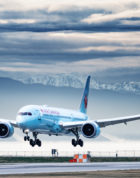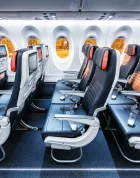In recent times, there has been a lot of movement in the Canadian ultra-low-cost carrier landscape.
Last month, Edmonton-based Flair Airlines had planes repossessed in scenes that some travellers might remember from the implosion of Jetsgo in the mid-2000s.
Meanwhile, the newest kid on the block, Canada Jetlines, joined forces with Air Miles, but has suspended its operation of routes within Canada for the time being. Rather, it appears to be moving in favour of destinations to the south, while also leasing out its aircraft and crew, at least until the fall.
Both of these moves come with recent announcements that flying in Canada is about to get more expensive.
Let’s take a look at what happened, and where it might go from here.
Dramatic Repossessions for Flair Airlines
On March 11, 2023, three Boeing 737 MAX 8 aircraft and one 737-800 leased by Flair Airlines from Airborne Capital Limited were grounded and later seized by bailiffs. The disruption affected up to 1,900 passengers, whose flights were cancelled abruptly, and forced Flair to scramble to accommodate the remainder of their scheduled flights.
The stated reason for this unfortunate situation was Flair’s alleged consistent delinquency and non-payment of their lease. Airborne claims it warned Flair multiple times that its failure to make good on its debts would result in the seizure of the aircraft, and the presence of bailiffs to facilitate the grounding and seizures would seem to indicate that they had strong backing.
Flair has fired back by filing a $50-million lawsuit, claiming that the confiscations were coordinated in conjunction with an unnamed airline, to whom Airborne was intending to lease the planes at a higher rate. The fact that the airplanes became available for lease fewer than two weeks later could be seen as giving this theory some legitimacy, as well.
Of course, this didn’t prevent many passengers from being left on the ground, and who were also given of a myriad of unrelated reasons for their cancellations.
Oddly enough, some received confirmation that Flair had claimed unscheduled mechanical issues that were definitely outside of the airline’s control as the reason for the disruption, therefore absolving Flair from paying compensation under Canada’s Air Passenger Protection Regulations.

If this sounds a bit confusing, remember that many airlines, and not just those of the ultra-low-cost variety, tend to lease rather than outright own their fleet.
Planes cost enormous amounts of money to purchase, so leasing arrangements, whereby an airline’s fleet is manned by its personnel but owned and leased out by a third party, make natural sense because the fees can be paid as revenue streams in.
Whatever the case may be, the planes have been seized and are now available for lease once again, and many customers have been left grounded.
Assuming Flair’s case isn’t thrown out, the legal drama between the airline and Airborne Capital will play out in the courts, but one wonders whether a company which allegedly could not pay its leasing fees possesses the cash reserves necessary for prolonged litigation.
Canada Jetlines Exits Canadian Airspace?
Toronto-based Canada Jetlines has been in the news most recently as the newest partner for the beleaguered Air Miles. Behind the scenes, though, the ultra-low-cost airline has been removing itself from Canadian routes and focusing instead on destinations further afield, in addition to leasing out its aircraft and crew.
When the airline launched in September 2022, its first flight was between Toronto (YYZ) and Calgary (YYC). It also operated flights between Toronto (YYZ) and Vancouver (YVR) for a brief period of time, and was competing with mainline and ultra-low-cost carriers alike on these busy routes.
Canadians have had at least one fewer choice on both routes ever since Jetlines abandoned both of them, at least for the time being. Jetlines hasn’t flown to Calgary since January 19, 2023, and its last flight to Vancouver was on January 8, 2023.

Currently, the airline flies between Toronto (YYZ) and Las Vegas (LAS) up to thrice weekly, and also from Toronto (YYZ) to Cancun (CUN) up to thrice weekly. It’s selling flights to Vancouver again as of September 2023, has announced (and pushed back) plans to fly to Orlando (MLB), and has also suggested plans to return to Calgary in the future, with nothing firm in place as of yet.
In the meantime, Jetlines has been securing wet leases for its fleet of two aircraft, including a five-month contract from the end of March until September 2023, which comes in addition to operating its routes to Las Vegas and Cancun. The airline hasn’t confirmed to whom it’s leasing its planes on an aircraft, crew, maintenance, and insurance (ACMI) lease, otherwise known as a wet or damp lease.
With just two commercial routes currently operating in addition to its wet leases, Jetlines has reduced its network but appears to be set to grow in the future. The airline will take delivery of three more Airbus aircraft later on this year, and has plans to have up to 15 aircraft in operation by 2025.
It will be interesting to see how the airline’s plans shape up as it adds more aircraft to its small fleet and navigates the Canadian aviation landscape. Will it continue to focus its efforts outside of Canada, or does it see some opportunity to grow domestically in a somewhat crowded market?
Jetsgo 2.0?
Unfortunately for customers, the tale that is now affecting Flair Airlines is not an unfamiliar one. In fact, it played out at a far more expansive level a decade and a half ago with the long-defunct budget airline Jetsgo.
Since the mid-2000s, the business model of ultra low-cost carriers has remained largely the same: keep costs as low as possible by cutting out all frills, and try to maximize revenue by selling any extra comforts above the bare minimum of legal requirements at a premium. Base fares often don’t make profits, while items like seat selection, baggage, or food and beverages do.
Add to this a model of leasing aircraft, which can cause a fleet to incur massive debts, and you have a recipe for disaster when an airline is financially unwell.
You may recall that Jetsgo imploded in dramatic fashion back in 2005. After three years of overambitious expansion and racking up an enormous bill of obligations to a number of parties, creditors demanded huge payments immediately while the CEO was returning from a ski trip.
When the airline couldn’t come up with the cash, Jetsgo swiftly went out of business, and thousands of Canadians were left stranded right before March Break, which is also known as one of the busiest travel periods of the year.

Fast forward to 2023, and while Flair has already lasted longer than Jetsgo’s measly three-year run, it appears to have made similar mistakes. They’ve expanded enormously by attaining more fleet capacity, which must have come at a significant cost.
Moreover, Flair announced this expansion shortly after the end of the pandemic, which had seen the collapse of revenues and a need for extensive government subsidies for a year or longer.
Time will tell if Flair will go the way of Jetsgo, but for now, customers should tread with caution. Most Jetsgo consumers didn’t receive any kind of recourse, because ultimately they were much lower on the priority list for compensation than Jetsgo’s other creditors. There also wasn’t a lot money left to give out, regardless.
The next time you’re eyeing up an attractive seat sale on Flair Airlines, perhaps to Mexico, you’ll need to make your own decisions about whether the deal is worth the potential risk. As it stands, the canny customer might wonder whether an airline that’s running into issues with aircraft lessors has the funds necessary to pay compensation under statutes such as the APPR.
It’s Not Getting Any Cheaper
Lastly, the Canadian federal government recently announced that air passengers will pay 33% more for security charges in an attempt to fund and improve the overall security experience. They aren’t necessarily significant fees and won’t take effect until May 2024, so it’s business as usual for now, at least for security fees.
You may also recall that most Canadian airports have increased the “airport improvement fees” in recent times, as airports struggle with post-pandemic debt burdens. You’ll now pay up to $42 for the privilege of using the airport for your journey, and there’s no way to skirt around paying it.
In any event, the taxes and fees that you can’t avoid paying on your air tickets have increased, and will continue to increase. For Canadian ultra-low-cost carriers, these fees often make up a good chunk of, and even exceed, the total fare you wind up paying.

Since Canadian airports aren’t taxpayer funded, and rather rely on a user-pay model, airports have to generate revenue to stay afloat. They do so by charging aeronautical fees to airlines, by charging non-aeronautical fees to businesses that operate within the airport, and by charging passengers directly with airport improvement fees.
Two of these three sources of income eventually are borne by passengers in one way or another. For ultra-low-cost carriers, it’s becoming even more difficult to keep costs down to attract passengers, and could be ultimately eating into the bottom line.
It’s worth noting that Canada has some of the highest taxes and fees in the world, and exactly how that affects the burgeoning ultra-low-cost carrier market for long-term viability remains to be seen.
Conclusion
Flair Airlines has seen four of its aircraft seized by frustrated lessors in the recent past. They’ve fired back with a multi-million dollar lawsuit, and while litigation is ongoing, those same aircraft have been offered to new would-be lessees.
On the other hand, Canada Jetlines appears to be focusing its efforts outside of Canada for the time being, as it will only operate flights to the United States and Mexico for the spring and summer months. It’s also wet leasing its aircraft and crew, although it hasn’t named with whom it has an agreement.
The old adage that you get what you pay for may feel trite in this specific situation, but ultimately Flair has found itself in a position no airline wants to be in. Time will tell if they can wriggle out of this situation, but for the moment the company’s leadership must be considering Jetsgo and hoping that they are learning that unfortunate carrier’s lessons, rather than reenacting its untimely fate.
Until next time, book carefully.




















